Lassen Regional Project: Weaverville Region
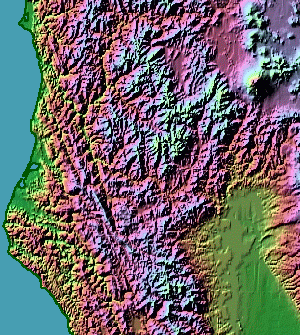 In Redding we are at the southeastern edge of the Klamath Mountains. Redding was well situated to become the supply city for mining throughout the area. Weaverville, on the other hand, was located at the heart of mining operations. Just over the small pass west of the town, where the road drops down into the Trinity River watershed, you will find an example of Placer Mining at its worst (an entire hillside washed away). Mining brought many people into the area, not only Americans and Europeans but also a large Asian labor force. After the mining ran its course, settlers remained to invest their energies in logging and farming. All of this, of course, had an immediate impact on the natives local to the area. But placer mining and forestry associated with construction had an enormous long-term impact in the entire Trinity-Klamath watershed as well.
In Redding we are at the southeastern edge of the Klamath Mountains. Redding was well situated to become the supply city for mining throughout the area. Weaverville, on the other hand, was located at the heart of mining operations. Just over the small pass west of the town, where the road drops down into the Trinity River watershed, you will find an example of Placer Mining at its worst (an entire hillside washed away). Mining brought many people into the area, not only Americans and Europeans but also a large Asian labor force. After the mining ran its course, settlers remained to invest their energies in logging and farming. All of this, of course, had an immediate impact on the natives local to the area. But placer mining and forestry associated with construction had an enormous long-term impact in the entire Trinity-Klamath watershed as well.
Native Americans of the Region
The Native Americans of our immediate region were the Wintu. While the Wintu were primarily valley people, closely related to the Nomlaki to the south and to the Patwin, further south, their traditional habitat extended into the mountains past Weaverville and into the Trinity River drainage. Just to the west, along the Trinity, there was a very small group called the Chimariko. And further along the Trinity there was a large and important group called the Hupa. The Hupa were closely linked by a common culture with the Yurok, Karuk, and Tolowa. (It should be mentioned that the Hupa are the only people of the entire state who were not taken off of their land; they have lived in Hoopa Valley, on the Trinity River, out of the deep past and into the present.)
Wintu
The Wintu were Penutian speakers who arrived in California at least 4,000 years ago. Traditional Wintu hunting and gathering was quite typical of most California Indians who inhabited the inland valleys and foothills. They had achieved a material culture of the Pacific Period based on the acorn as their staple food. There were seven different species of acorn-bearing oak trees in the Central Valley and a large tree could yield from 1/4 to 1/2 ton of acorns in the autumn. A typical family probably harvested a couple tons of acorns in a season, enough to get through a second year, if necessary. Since acorns average above 40% carbohydrate, with around 3% protein and 6% fat, the family's granary could provide more calories of food energy per day than required by six people. (This can be compared with corn at 74% carbohydrate, 9% protein, and 2% fat.)
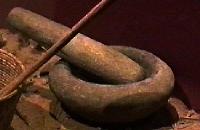 Acorns were harvested communally in the fall and harvesting was usually regulated carefully so as to assure equitable distribution. Village elders were usually involved in monitoring trees and harvesting could not begin until a community "First Fruits" ceremony had been celebrated. Nevertheless, when harvesting began, it was often the case that a family might have rights on one or more trees. Acorns were an excellent staple food precisely because the hard shell prevented spoilage of the harvested nut. Acorns could be stored in large granaries which prevented insect infestation and invasion by small animals. Acorns were extracted from the granary on a daily basis and pounded to break open the hard shell. The fibrous husk was usually cut off with a small obsidian blade and, then, the hardened meat was pounded with a pestle. (Grinding brings out the oils and produces something like peanut butter.) Once reduced to acorn meal, the tannic acid had to be removed in order to render it palatable. Acorn meal was usually cooked into a "mush" which could be fortified or seasoned in a wide variety of ways (different seeds, vegetables, fruits, or meats).
Acorns were harvested communally in the fall and harvesting was usually regulated carefully so as to assure equitable distribution. Village elders were usually involved in monitoring trees and harvesting could not begin until a community "First Fruits" ceremony had been celebrated. Nevertheless, when harvesting began, it was often the case that a family might have rights on one or more trees. Acorns were an excellent staple food precisely because the hard shell prevented spoilage of the harvested nut. Acorns could be stored in large granaries which prevented insect infestation and invasion by small animals. Acorns were extracted from the granary on a daily basis and pounded to break open the hard shell. The fibrous husk was usually cut off with a small obsidian blade and, then, the hardened meat was pounded with a pestle. (Grinding brings out the oils and produces something like peanut butter.) Once reduced to acorn meal, the tannic acid had to be removed in order to render it palatable. Acorn meal was usually cooked into a "mush" which could be fortified or seasoned in a wide variety of ways (different seeds, vegetables, fruits, or meats).
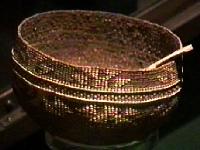 Cooking throughout California was performed in baskets made by the women. The boiler basket was large and had high sides. It was filled with enough water and acorn meal; then, hot rocks were taken from the fire and stirred into the basket until the desired temperature was achieved. Cooked mush was transferred to smaller eating bowls of the same construction. Mush was eaten with fingers or with spoons made from half shells, wood, or carved antler.
Cooking throughout California was performed in baskets made by the women. The boiler basket was large and had high sides. It was filled with enough water and acorn meal; then, hot rocks were taken from the fire and stirred into the basket until the desired temperature was achieved. Cooked mush was transferred to smaller eating bowls of the same construction. Mush was eaten with fingers or with spoons made from half shells, wood, or carved antler.
Many other vegetable resources were harvested in Wintu country. These included buckeye nuts, manzanita berries, clover, miner's lettuce, hazel nuts, pine nuts, and a wide variety of other berries. The mainstay of hunting were deer and they were hunted either individually or communally. Occasionally bear were hunted communally, though grizzly bear was not hunted or eaten. Rabbits were hunted communally by driving rabbits into snares where they could be killed. Quail could be treated similarly. Even grasshoppers could be harvested in large enough numbers for food if they were herded into the middle of a field and then set afire.
Rivers and streams provided fish seasonally. Salmon was the preferred fish and runs lasted from May through December. Salmon could be netted or speared and they were usually baked in pits. The Wintu had not developed the technology for long-term preservation of salmon so it was not a staple food. Like other foothill Indians, fish that were not eaten immediately were air dried and kept for short periods of time. Hard dried salmon might be pounded into a flour. Steelhead, suckers, and freshwater clams were also harvested. All in all, the California Indian diet was rich and varied.
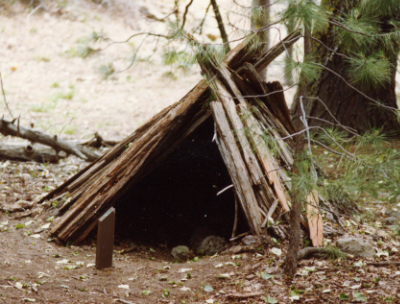 The abundance of food allowed the Wintu to live in permanent villages within nine triblet groups. A village might house 20 to 150 people, most of whom would be related. Ordinary family shelters were usually conically shaped houses made from long pine or cedar bark planks and caulked with various small plant materials. The Wintu also made larger lodges that were semi-subterranean and up to 20 feet across. The roof could be covered with bark, small branches, and even dirt. The lodge was usually the residence of the village headman but also served generally as a meeting place and sweat lodge for the men. California's Indian women usually spent the time of their menstruation in isolation so each village had a small menstrual hut near the outer edge. This was usually a dome-shaped brush structure. Other constructed items were large granaries for acorn storage and drying racks for fish and meat.
The abundance of food allowed the Wintu to live in permanent villages within nine triblet groups. A village might house 20 to 150 people, most of whom would be related. Ordinary family shelters were usually conically shaped houses made from long pine or cedar bark planks and caulked with various small plant materials. The Wintu also made larger lodges that were semi-subterranean and up to 20 feet across. The roof could be covered with bark, small branches, and even dirt. The lodge was usually the residence of the village headman but also served generally as a meeting place and sweat lodge for the men. California's Indian women usually spent the time of their menstruation in isolation so each village had a small menstrual hut near the outer edge. This was usually a dome-shaped brush structure. Other constructed items were large granaries for acorn storage and drying racks for fish and meat.
Americans usually assume that Indians were ruled by "chiefs" and have the Plains Indians in mind. California Indian communities had no concept of political "rule" and the so-called "headman" was far more nearly a cultural icon than political organizer. The Headman (the Wi in Wintun) was usually hereditary and always learned in that groups culture. Villagers gave the Headman food and other resources, but he, in return, was expected to re-distribute resources to people in need. In effect, the Headman was like a"bank". He was also responsible for organizing social events and ceremonies, as well as all communal hunting, fishing, and gathering activities. The Headman kept a sharp eye out for abuses of social customs, especially marriage customs and taboos.
Hupa
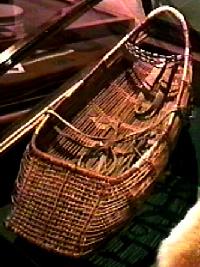 The Hupa people, like several other people of the region, were Athapascan speakers. While there is no data regarding their origins, linguistic studies indicate fairly recent immigration to California from the north. Athapascan speakers were the primary occupants of interior Alaska and Western Canada and they migrated south in various groups, beginning about 1000 years ago. (The Navajo, for instance, are Athapascan speakers.)
The Hupa people, like several other people of the region, were Athapascan speakers. While there is no data regarding their origins, linguistic studies indicate fairly recent immigration to California from the north. Athapascan speakers were the primary occupants of interior Alaska and Western Canada and they migrated south in various groups, beginning about 1000 years ago. (The Navajo, for instance, are Athapascan speakers.)
Salmon was the staple food for the Hupa. There were several major runs of salmon along the Trinity River each year and fish were netted from shoreline platforms or speared as they passed over weirs constructed across the river. Some fishing was performed with hook-line-and-sinker. As part of the whole northwest material culture, the Hupa had achieved a technology for catching, processing, and smoking salmon so that the salmon could be preserved throughout the year as a staple food. Steelhead and eel could be treated in the same ways. Hupa made shallow canoes by carving out the interior of a long log. These could be used for fishing, net laying, or simply transportation up-or-down river.
Since the general environment was not dissimilar to that of the Wintu, the Hupa could also hunt deer and elk as well as smaller animals. Local oak trees provided carbohydrate-rich acorns to supplement salmon. Being closer to the coastal rainforest than the Wintu, the Hupa exploited even more vegetable, nut, and fruit resources.
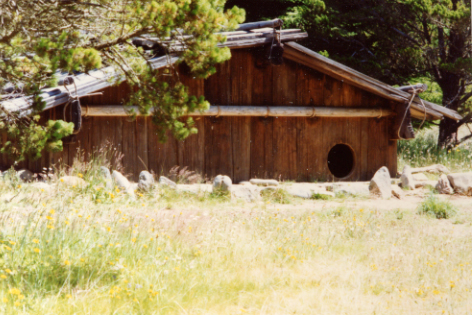 [Click on house to see inside]The Hupa, like all of the people along the northwest coast all the way into Washington and British Columbia, harvested long planks from living cedar trees to fashion the siding and roofs for large permanent houses. There was a river-rock porch along the front of the house and the doorway (an oval or round hole large enough for a person but too small for a bear) was usually on the right side of the front. Crawling through the doorway, you found yourself on a gallery that surrounded a semi-subterranean interior. The gallery was used for storage and could be sectioned off with mats or screens. A notched log ladder got you down inside the living space where there was a fire pit. The Hupa house served as living quarters and food processing factory. Split salmon filets would be hanging from racks above the fire pit and individual roof panels would be moved this-way-or-that to control the smoking process.
[Click on house to see inside]The Hupa, like all of the people along the northwest coast all the way into Washington and British Columbia, harvested long planks from living cedar trees to fashion the siding and roofs for large permanent houses. There was a river-rock porch along the front of the house and the doorway (an oval or round hole large enough for a person but too small for a bear) was usually on the right side of the front. Crawling through the doorway, you found yourself on a gallery that surrounded a semi-subterranean interior. The gallery was used for storage and could be sectioned off with mats or screens. A notched log ladder got you down inside the living space where there was a fire pit. The Hupa house served as living quarters and food processing factory. Split salmon filets would be hanging from racks above the fire pit and individual roof panels would be moved this-way-or-that to control the smoking process.
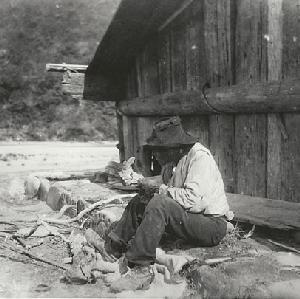 Hupa houses were arranged in settlements along the Trinity River. The men built sweat lodges that were almost subterranean and utilized river rock crawl spaces and low cedar panel roofs. Only women and children actually slept in the houses; the men socialized, worked, and slept at the sweat lodge. Woodworking was one of the main male industries and the men made planks, storage chests, platters, bowls, spoons, and stools. They also manufactured bows and arrows as well as fishing equipment.
Hupa houses were arranged in settlements along the Trinity River. The men built sweat lodges that were almost subterranean and utilized river rock crawl spaces and low cedar panel roofs. Only women and children actually slept in the houses; the men socialized, worked, and slept at the sweat lodge. Woodworking was one of the main male industries and the men made planks, storage chests, platters, bowls, spoons, and stools. They also manufactured bows and arrows as well as fishing equipment. 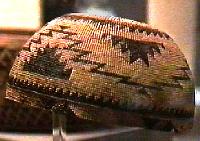 Women were basketweavers and employed the twining technique of basket production exclusively. Everyone wore basketry caps. As in the rest of California, the Hupa cooked and ate with baskets. Smoking was an important part of male society and they manufactured beautiful pipes from wood, often inladed with steatite (soapstone) which could be easily carved.
Women were basketweavers and employed the twining technique of basket production exclusively. Everyone wore basketry caps. As in the rest of California, the Hupa cooked and ate with baskets. Smoking was an important part of male society and they manufactured beautiful pipes from wood, often inladed with steatite (soapstone) which could be easily carved.
Life was so good among the Hupa that they had developed a complex mythology relating to the natural forces that provided for them. One of these figures, for instance, was Nepewo, the "headman of the salmon," who lived across the ocean. In effect, salmon was a whole unified being that was never actually killed. Nepewo declared, "I shall travel as far as the river extends. I shall leave my scales on nets and they will turn into salmon, but I myself shall go by and not be killed." Maintenance of a good relationship with this spiritual being was all that was required for continuation of their plentiful staple food. And they were extremely deliberate about this relationship. No one could catch and eat a salmon until after the First Salmon Ceremony in which an appropriately purified ritual formulist, exercising extremely precise traditional movements, caught, killed, and ate the first salmon of the season. To violate this pattern of annual reunion with the salmon would risk the well being of the entire people. Similarly, the annual White Deerskin Dance and the Jumping Dance were performed with the specific intention of setting themselves right with the powers of the universe, in effect, bringing the Hupa people back into a constructive balance.
History After White Contact
Approximately 75% of the Wintu died in a malaria epidemic that was set off by some Oregon trappers in 1830-33. In 1846 the Mexican government was still making land grants in the Upper Sacramento Valley and much of the Wintu hunting territory was overrun by sheep and cattle. Mining operations degraded rivers in the region, leading to a loss of fishing resources. Throughout the decade from 1840 to 1850, ranchers and miners executed numerous massacres among the Wintu, including one instance of a "friendship feast" in which they poisoned the food. While stability was sought through "The Cottonwood Treaty" and establishment of Fort Reading, in 1852, degradation of natural resources continued to reduce Wintu food supplies and competition for land continued to encourage Whites to murder Indians. As the second half of the 19th Century continued, Wintu were either killed or deported from their natural habitat to reside in reservations in Mendocino.
The Hupa were far more fortunate than other California Indians. While mining and forestry up the Trinity River gradually degraded the salmon fishery and while White settlers moved downriver into Hupa extended territory, the core traditional territory, Hupa Valley (running north-south to the point where the Trinity empties into the Klamath River), was retained by the Hupa people.
 In Redding we are at the southeastern edge of the Klamath Mountains. Redding was well situated to become the supply city for mining throughout the area. Weaverville, on the other hand, was located at the heart of mining operations. Just over the small pass west of the town, where the road drops down into the Trinity River watershed, you will find an example of Placer Mining at its worst (an entire hillside washed away). Mining brought many people into the area, not only Americans and Europeans but also a large Asian labor force. After the mining ran its course, settlers remained to invest their energies in logging and farming. All of this, of course, had an immediate impact on the natives local to the area. But placer mining and forestry associated with construction had an enormous long-term impact in the entire Trinity-Klamath watershed as well.
In Redding we are at the southeastern edge of the Klamath Mountains. Redding was well situated to become the supply city for mining throughout the area. Weaverville, on the other hand, was located at the heart of mining operations. Just over the small pass west of the town, where the road drops down into the Trinity River watershed, you will find an example of Placer Mining at its worst (an entire hillside washed away). Mining brought many people into the area, not only Americans and Europeans but also a large Asian labor force. After the mining ran its course, settlers remained to invest their energies in logging and farming. All of this, of course, had an immediate impact on the natives local to the area. But placer mining and forestry associated with construction had an enormous long-term impact in the entire Trinity-Klamath watershed as well. Acorns were harvested communally in the fall and harvesting was usually regulated carefully so as to assure equitable distribution. Village elders were usually involved in monitoring trees and harvesting could not begin until a community "First Fruits" ceremony had been celebrated. Nevertheless, when harvesting began, it was often the case that a family might have rights on one or more trees. Acorns were an excellent staple food precisely because the hard shell prevented spoilage of the harvested nut. Acorns could be stored in large granaries which prevented insect infestation and invasion by small animals. Acorns were extracted from the granary on a daily basis and pounded to break open the hard shell. The fibrous husk was usually cut off with a small obsidian blade and, then, the hardened meat was pounded with a pestle. (Grinding brings out the oils and produces something like peanut butter.) Once reduced to acorn meal, the tannic acid had to be removed in order to render it palatable. Acorn meal was usually cooked into a "mush" which could be fortified or seasoned in a wide variety of ways (different seeds, vegetables, fruits, or meats).
Acorns were harvested communally in the fall and harvesting was usually regulated carefully so as to assure equitable distribution. Village elders were usually involved in monitoring trees and harvesting could not begin until a community "First Fruits" ceremony had been celebrated. Nevertheless, when harvesting began, it was often the case that a family might have rights on one or more trees. Acorns were an excellent staple food precisely because the hard shell prevented spoilage of the harvested nut. Acorns could be stored in large granaries which prevented insect infestation and invasion by small animals. Acorns were extracted from the granary on a daily basis and pounded to break open the hard shell. The fibrous husk was usually cut off with a small obsidian blade and, then, the hardened meat was pounded with a pestle. (Grinding brings out the oils and produces something like peanut butter.) Once reduced to acorn meal, the tannic acid had to be removed in order to render it palatable. Acorn meal was usually cooked into a "mush" which could be fortified or seasoned in a wide variety of ways (different seeds, vegetables, fruits, or meats). Cooking throughout California was performed in baskets made by the women. The boiler basket was large and had high sides. It was filled with enough water and acorn meal; then, hot rocks were taken from the fire and stirred into the basket until the desired temperature was achieved. Cooked mush was transferred to smaller eating bowls of the same construction. Mush was eaten with fingers or with
Cooking throughout California was performed in baskets made by the women. The boiler basket was large and had high sides. It was filled with enough water and acorn meal; then, hot rocks were taken from the fire and stirred into the basket until the desired temperature was achieved. Cooked mush was transferred to smaller eating bowls of the same construction. Mush was eaten with fingers or with  The abundance of food allowed the Wintu to live in permanent villages within nine triblet groups. A village might house 20 to 150 people, most of whom would be related. Ordinary family shelters were usually conically shaped houses made from long pine or cedar bark planks and caulked with various small plant materials. The Wintu also made larger lodges that were semi-subterranean and up to 20 feet across. The roof could be covered with bark, small branches, and even dirt. The lodge was usually the residence of the village headman but also served generally as a meeting place and sweat lodge for the men. California's Indian women usually spent the time of their menstruation in isolation so each village had a small menstrual hut near the outer edge. This was usually a dome-shaped brush structure. Other constructed items were large granaries for acorn storage and drying racks for fish and meat.
The abundance of food allowed the Wintu to live in permanent villages within nine triblet groups. A village might house 20 to 150 people, most of whom would be related. Ordinary family shelters were usually conically shaped houses made from long pine or cedar bark planks and caulked with various small plant materials. The Wintu also made larger lodges that were semi-subterranean and up to 20 feet across. The roof could be covered with bark, small branches, and even dirt. The lodge was usually the residence of the village headman but also served generally as a meeting place and sweat lodge for the men. California's Indian women usually spent the time of their menstruation in isolation so each village had a small menstrual hut near the outer edge. This was usually a dome-shaped brush structure. Other constructed items were large granaries for acorn storage and drying racks for fish and meat. The Hupa people, like several other people of the region, were Athapascan speakers. While there is no data regarding their origins, linguistic studies indicate fairly recent immigration to California from the north. Athapascan speakers were the primary occupants of interior Alaska and Western Canada and they migrated south in various groups, beginning about 1000 years ago. (The Navajo, for instance, are Athapascan speakers.)
The Hupa people, like several other people of the region, were Athapascan speakers. While there is no data regarding their origins, linguistic studies indicate fairly recent immigration to California from the north. Athapascan speakers were the primary occupants of interior Alaska and Western Canada and they migrated south in various groups, beginning about 1000 years ago. (The Navajo, for instance, are Athapascan speakers.) [Click on house to see inside]
[Click on house to see inside] Hupa houses were arranged in settlements along the Trinity River. The men built
Hupa houses were arranged in settlements along the Trinity River. The men built  Women were basketweavers and employed the twining technique of basket production exclusively. Everyone wore basketry caps. As in the rest of California, the Hupa cooked and ate with baskets. Smoking was an important part of male society and they manufactured beautiful pipes from wood, often inladed with steatite (soapstone) which could be easily carved.
Women were basketweavers and employed the twining technique of basket production exclusively. Everyone wore basketry caps. As in the rest of California, the Hupa cooked and ate with baskets. Smoking was an important part of male society and they manufactured beautiful pipes from wood, often inladed with steatite (soapstone) which could be easily carved.